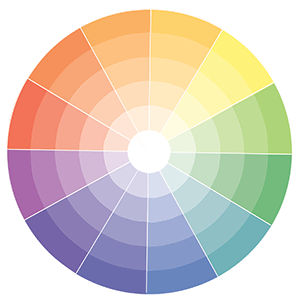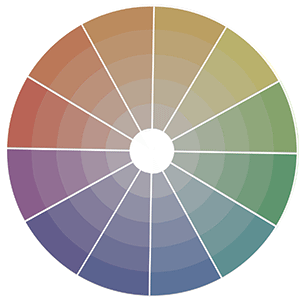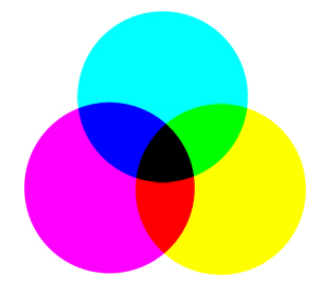Color Wheel
Color Wheel
Decoding the Color Spectrum
Mastering Color for Your Corporate Brand
Craft a Cohesive Color Palette for Your Digital Presence
Unveiling the secrets of the color wheel! Go beyond the basics of hues and delve into tints, tones, shades, complementary colors, and advanced harmony techniques like split complementary, triadic, and monochromatic palettes. Learn how to leverage CMYK, RGB, primary and secondary colors, and understand how warmth and coolness impact brand perception. Design a visually captivating brand identity that resonates across all your digital marketing channels.

Tints
A tint is a hue mixed with pure white. Sometimes they are referred to as pastels, but the true definition of a tint is adding white to the pigment. A tint lightens the color but does not brighten the hue.

Tones
A tone is a hue mixed with gray. The gray is created by mixing white and black, not a neutral gray that is created with color. The gray will tone the hue. As gray is added, the duller the hue becomes.

Shades
Shades are created by mixing black with any hue. The black darkens the hue. The more black added, the darker the hue becomes until the hue is no longer detectable in the shade.

Monochromatic
Monochromatic color scheme uses tints, tones, and shades of a color on the color wheel.

Complementary
Complementary color scheme uses colors that are opposite on the color wheel.

Split Complementary
To create a Split Complementary color scheme, start by choosing a color. Then choosing two colors on either side of the opposite of the first color on the color wheel.

Double Split Complementary
Double Split Complementary uses a combination of colors that contain two sets of complements like red and green or blue and orange.

Side Complementary
Using color in combination with another color on either side of its complement on the color wheel.

Square Complementary
A Square Tetradic color scheme uses four colors arranged into two complementary pairs. There is a balance between warm and cool colors. The square color scheme is evenly spaced around the color circle.

Analogous
Analogous Color Scheme are the use of two to five colors that are adjacent to each other on the color wheel.

Double Complementary (Rectangle Tetradic)
The Double Complementary color scheme uses four colors arranged into two complementary pairs. This color scheme offers many varieties. When using this color scheme, one color should be the dominant color while the others are secondary.

Triad
Triad uses three colors equally spaced from each other on the color wheel.

Hue
A Square Tetradic color scheme uses four colors arranged into two complementary pairs. There is a balance between warm and cool colors. The square color scheme is evenly spaced around the color circle.

Chroma
Chroma is sometimes referred to as saturation, purity, or color intensity. Chroma is the vividness of a color. High chrome is free of white, grey, and black. Chroma can be measured in absolute on the Munsell Color Scale. Munsell Color Scale is a three-dimensional scale based on three properties of color measuring hue (Basic Color) Chroma (color intensity) and value (lightness).

CMYK
CMYK is used for print. It stands for Cyan, Magenta, Yellow, and Black. CMYK is used in 4-color process printing. Also referred to as full-color printing. All other colors can be created by combining various amounts of CMYK. It’s a subtractive process, as the more color is used, the more light is removed or absorbed to create the color. Cyan, Magenta, and yellow combined create a dark brown, adding k or black completely removes all light. Our eyes read this as black.

RGB
Blue. Red, Green is associated with our electronic device displays, monitors, tablets, Pen tablet displays, cell phones, and digital cameras, RGB is supported in all browsers. Each parameter is between 0-255.
Primary Colors
Red, yellow and blue are the basic colors. They cannot be made by mixing any other colors. All other colors are created by these three hues.
Secondary Colors
Secondary colors are green, orange and purple. These colors are created by using the primary colors: green - mixing yellow and blue, orange - mixing red and yellow, purple mixing red and blue.


Primary Color
Red


Primary Color
Blue


Primary Color
Yellow


Secondary Color
Orange


Secondary Color
Green


Secondary Color
Purple
Warm Colors
Cool Colors


Warm Color
Yellow


Warm Color
Orange


Warm Color
Red


Cool Color
Green


Cool Color
Blue


Cool Color
Purple
Intensity
Also referred to as Chroma and Saturation. The brightness of a color.


Hue
Yellow


Hue
Orange


Hue
Red


Hue
Yellow Green


Hue
Green


Hue
Green Blue


Hue
Blue


Hue
Violet Blue


Hue
Purple


Hue
Lavender


Hue
Pale Pinks


Hue
Pinks
Tertiary Colors
There are six tertiary colors. Each tertiary color is made by mixing a primary color with an adjacent secondary color on the color wheel: yellow-orange, red-orange, red-violet, blue-violet, blue-green, and yellow-green.


Hue
Yellow


Hue
Orange


Hue
Purple


Hue
Blue


Hue
Blue-Green


Hue
Green
Color Hex
Color HEX is also supported by all browsers. The hexadecimal system is #RRGGBB or # Red, Red, Green, Green, Blue, Blue.
Hexadecimal Number Scale
Decimal Binary Hexadecimal
0 0 0
1 1 1
2 10 2
3 11 3
4 100 4
5 101 5
6 110 6
7 111 7
8 1000 8
9 1001 9
10 1010 A
11 1011 B
12 1100 C
13 1101 D
14 1110 E
15 1111 F
One hexadecimal digit can have 16 values ranging from 0 – 15. One Byte is two hexadecimal digits together. This adds up to 16 x 16 = 256 different levels of color.
Each color can represent 256 colors ranging from 0-255. That means 256 x 256 x 256 + 2563 0r 16,777,216 possible color combinations.
When devices claim they have 16 million colors, this is the reference.
Value Scale
Value describes the lightness and darkness of a color. Ranging from white at one end of the value scale to black at the other end of the scale. The lighter the color the closer to white. The darker the color the closer to black with a range of gradients in between. The greyscale. Light to dark on a scale of 1-10.

1

2

3

4

5

6

7

8

9

10

Creative Brand Land
Where Creativity Brings Brands to Life®
Creative Brand Land combines creativity and imagination to build exceptional Corporate Branding & Digital Marketing Campaigns. We specialize in all aspects of corporate branding from Color Theory, professional Typography Design, Brand Archetype, hand-drawn Icon development, unique Social Media style, and Digital Marketing Campaigns that set your company from the crowd. The Creative Brand Land Method combines exceptional knowledge, expertise, talent, creativity, and imagination to develop a unique corporate ID for your company.
Ready to take your business to the next level?
Top of page
Mission Statement
The art of bringing brands to life - start to finish. ™
Sign up for Marketing Tips, How to's, Inspiration and more
For more information contact Christine Solazzi at info@ChristineSolazzi.com
Address; Hobe Sound, Florida 33455